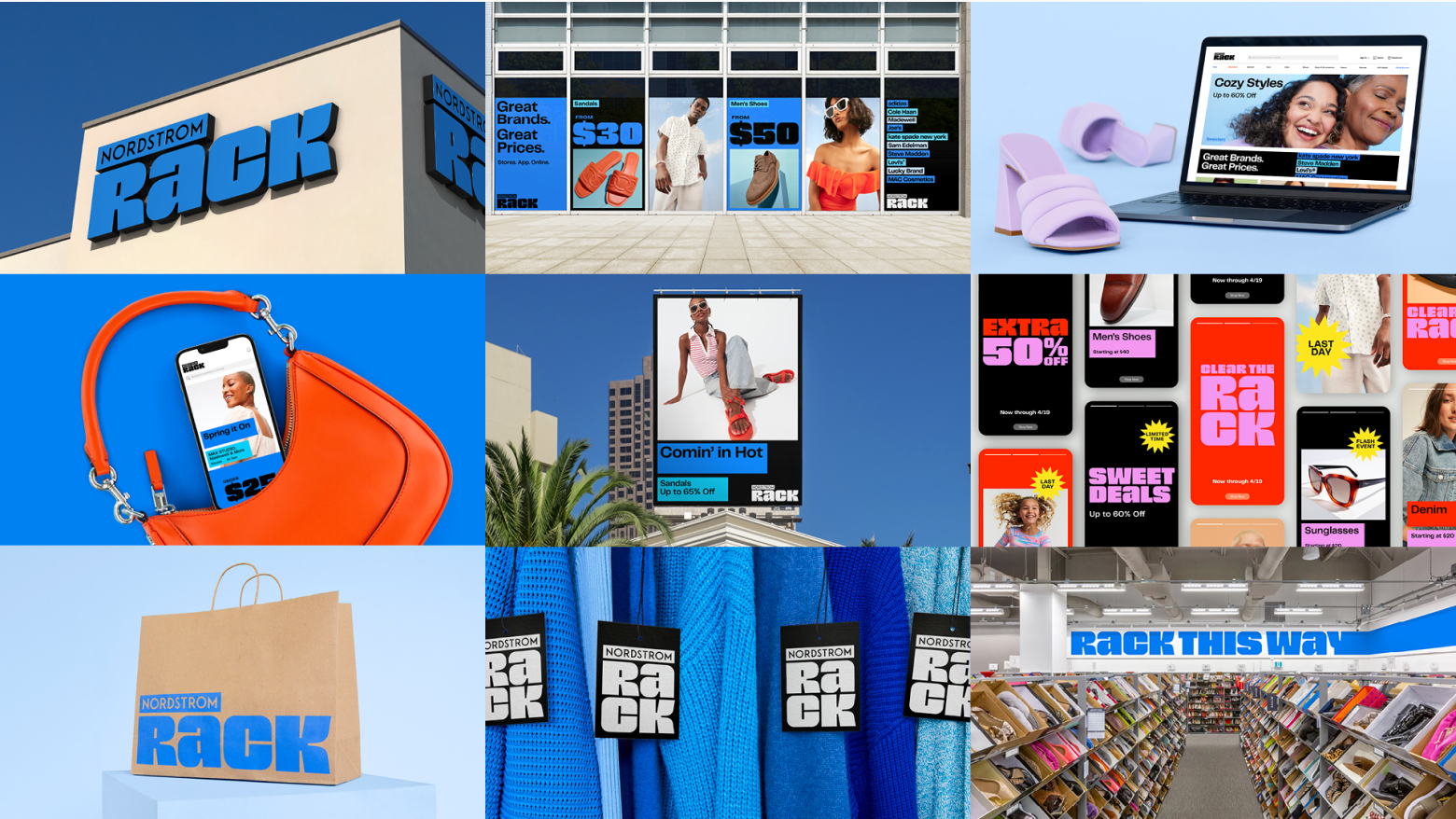
Reflections on rebranding with JKR
Nordstrom Rack is a US-based fashion retailer focused on offering "Great Brands at Great Prices" through affordability and accessibility. During a recent rebrand in collaboration with global branding agency Jones Knowles Ritchie (JKR), it sought to appropriately differentiate the retailer from its sister brand, Nordstrom, and from its competitors with a modern, forward-facing mindset.
We sat down with Red Godfrey, VP of Creative at Nordstrom, along with Lisa Smith, Global Executive Creative Director, and Hayley Burnham, Group Strategy Director from JKR, to discuss this new identity for the brand.

Karl Wikström: So I'm going to start with a big question, and then we'll get more specific as we go along. Tell us about the rebrand for Nordstrom Rack!
Red Godfrey: When I first inherited the Rack brand, I immediately wanted to tackle our brand identity because I felt we were doing a disservice to our customers. When you look at this area of the market, there's not a lot of attention paid to really high-quality, promotional design. And so that was something that was important for us to focus on. In the last few years, the growth of the Rack brand has become a big priority for us as a company. So, the focus was justified to meet and support the business growth that we were looking for.
Karl Wikström: And how did you go about starting that discussion, that process of rebranding?
Lisa Smith: Initially, we received an identity brief, but it wasn't considered a complete rebrand at that time. Our focus was primarily on visual updates. However, as the discussion evolved, these components gradually shifted from being the main focus to becoming part of a larger puzzle, from the logo, tone of voice, and messaging to how the brand moves with motion design.
Red Godfrey: Yeah, I think the brief was we wanted a new visual identity. If you go to the executive team and say, “I want to change the logo,” you're not going to be able to do it. It’s about considering what we needed to communicate and why the way you do that matters, building a clear business case. Slowly, the logo became part of this bigger discussion about what we were conveying, and then, ultimately, that covered every aspect of our branding.
Toby Williams: Was there a particular challenge you faced as a retail brand, which is a platform for other brands when you're selling designer brands and still trying to create a strong sense of identity?
Hayley Burnham: I think it can be really easy for a retailer to feel, “If we do anything that's not simple and straightforward and quiet, then we’ll be getting in the way of other brands.” And on some level that can be true. If you're too loud and you're too rigid, then you don't create space for the brands that you're selling.
But I think part of our challenge was to land on a brand positioning and a creative idea that created more distinctiveness for Nordstrom Rack while at the same time still allowing for the flexibility to help the brands it stocks shine. The answer is a system that can work with whatever different brands it needs to. And I think where we landed allowed for both to be true.

Karl Wikström: What do you think were the key factors that made the rebrand successful from your point of view?
Hayley Burnham: For me, it was landing on an insight that's really true — one that nobody else has arrived at. We built a deep understanding of who the Rack customer was and took the time to really recognize just how badass this customer was.
Lisa Smith: Absolutely. It's so disappointing, from a design perspective how mistreated this category has been. But it's so empowering to shop to save and be savvy in that way. So why can't the brand identity reflect that kind of badass real swagger that a consumer who buys that way can have? And so, of course, the identity expression of this brand has a lot of gravitas; it’s very bold and agile.
Red Godfrey: When you ask what made it successful, I’d say the number one thing for me was the partnership between our two teams. We leveraged the skill sets of both teams, and that, along with not being willing to settle for anything less than the best possible solution, really ensured the success of this experience.

Karl Wikström: That's fantastic. It leads me to another question which I wanted to ask. Has there been a challenge in giving Nordstrom Rack its own direction while not straying too far from the kind of sibling brand, or mother brand, of Nordstrom?
Hayley Burnham: I think it’s interesting that you mention the word "sibling." We had many conversations about what the relationship is between the two brands. Part of the process was identifying the core tenants of both Nordstrom and Nordstrom Rack and understanding what they meant for Nordstrom and what they meant for Rack.
Red Godfrey: I remember one of our executives saying to me afterward, “Somehow, you've made Rack stand on its own from Nordstrom. But you've also somehow incorporated the Nordstrom logo within the Rack logo that brings them closer.” It was a really interesting perception of what we did.
Toby Williams: And how does that tie into your aim of “future-proofing” the Rack brand?
Lisa Smith: That was one of the design challenges that we needed to overcome. At the moment, obviously, the Rack system is still manually designed and templated. But there are so many ways, when I think of tools like Frontify and where automated templates are going, that you could easily create a set of tools that could be transferred. I think there is still a way to go with that sort of technology, but the idea was to build a system that could be ready for automation, too.
Toby Williams: It's really interesting to see how you could build that space that can allow automation but also ensure a level of human control, creatively and practically.
Lisa Smith: And digitally as well. Obviously, one of the first places we looked to roll this brand out was in the e-commerce space. We really had to think digital-first because that's obviously the most effective way. But it's also a very big commitment in terms of improving the e-commerce side of the business. Then, of course, there are new stores being opened, so we had to think, “How can those stores start to take on the new identity?” It was almost like there was a modular rollout to the modular design system.
Karl Wikström: That’s brilliant. When you talk about the amazing complexity of this modular system, what were the risks you saw coming in? Was there something you were particularly wary about in terms of pulling this off successfully?
Red Godfrey: From my standpoint, the risk with any rebrand is always your physical assets. Digitally, you can rebrand overnight: As soon as the work's done, you can put it out into the world. When you have 300 stores nationwide with giant Nordstrom Rack logos all over the place, you start looking at the cost of a rebrand, and it really adds up. Needless to say, you need to have a strong stomach and get very comfortable with the fact that you’re going to have to fight for your rebrand!

Karl Wikström: Brilliant. I think we're getting close to how much time we can steal from you! So, some final questions. What do you think is important for a successful rebrand today? If you look at what you've learned through this process, what are the key things to get right? And how has that changed from, say, five or 10 years ago?
Lisa Smith: I actually don't think the fundamentals have changed in rebranding. You need to have a business challenge and a business imperative. And you need to solve it with a core brand idea that sits at the heart that you truly bring to life throughout everything you do.
What has changed, however, is all the different ways that you can bring it to life. The world around has changed, but the core fundamentals of how a brand gets to the answer remain the same. I get very excited by the new places and ways the brands can show up. There's nothing that's changed about how I get to the answer, but everything's changed about the way that I use that answer.
Red Godfrey: With the evolution of digital capabilities, you need to think beyond the static rules and guidelines, yes, look, feel, voice, but you also need to consider how the brand will behave, move, and sound. The other thing you're up against is that everybody's a designer today. You know what I mean? Everybody talks about fonts, everybody's a photographer, and everybody's a videographer. There is more content than ever, and we’re all goldfish, so the bar is higher than it's ever been to capture attention and recognition.
Karl Wikström: Quick-fire round before we let you go. What is the one piece of critical advice you would give to a brand embarking on a rebrand today?
Lisa Smith: It can never be a vanity project. It needs to have a business reason.
Hayley Burnham: Don't wait until your brand is failing to do a rebrand because that might be too late. Rebranding when you're on top is sometimes the most powerful and impactful time to do it.
Red Godfrey: I think we're all oscillating around the same thing: Choose your partner wisely, and be really clear about what you want to get out of it. And then be ready!